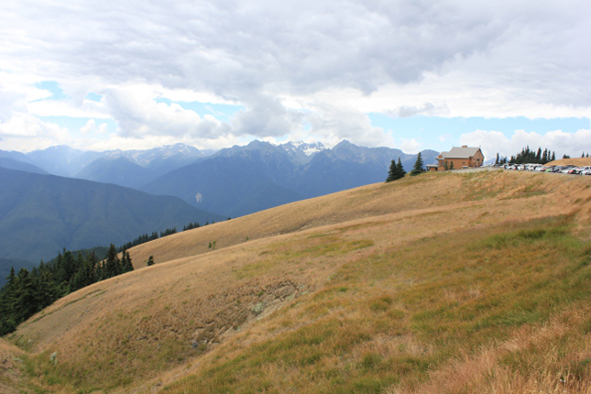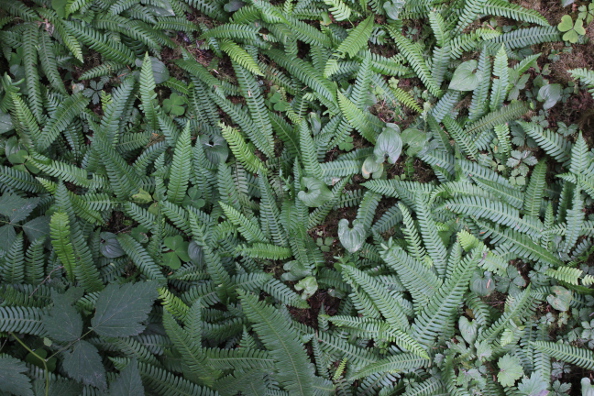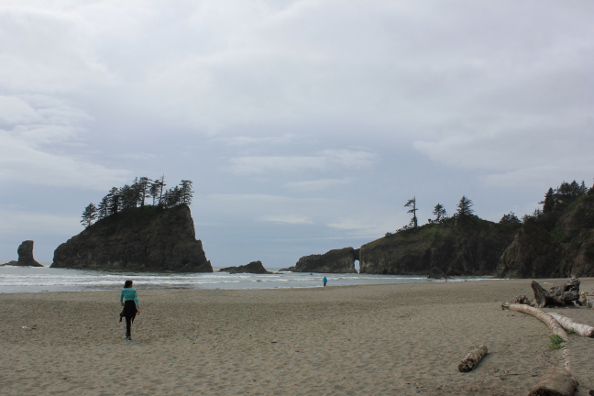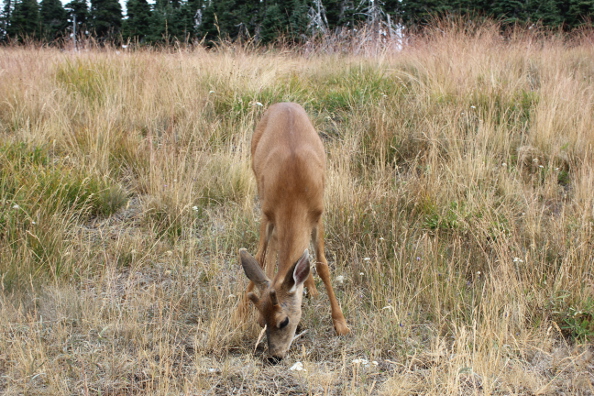Olympic National Park, which encompasses more than 900,000 acres, makes up the bulk of the Olympic Peninsula, an arm of land in western Washington whose isolation helped develop the area’s unique abundance of endemic plant and animal species.

Hurricane Ridge Visitor Center (Photo: Jeffrey Rindskopf)
A single orange kayak cuts through the still surface of Lake Crescent like a knife through turquoise gelatin. The ripples it creates reach the shore just yards from my campsite, where I’m beginning to wade into the shallows of the frigid lake. For a moment the lake bottom becomes visible through the pristine water as the gentle waves pass, then disappear.
The lake’s surface becomes a mirror once more, perfectly reflecting the lush greenery of the mountains looming on the other side. The lake and surrounding peaks occupy only one small corner in the northern part of the enormous Olympic National Park.
The Olympic Mountains divide the Peninsula into two halves, which together contain three entirely distinct ecosystems. In the shadow of the mountains opposite Lake Crescent, cars dart along a narrow two-lane highway, some headed towards the rugged Pacific shores and temperate rainforests in the west, and some towards the dry subalpine brush in the east.

Lake Crescent (Photo: Jeffrey Rindskopf)
The Rainforest
There is no blue sky on this part of the Peninsula, only a fog overhead that perpetually pours misty rain over the dense landscape. I pass through the sleepy town of Forks, whose only distinct features are the roadside stands selling “Twilight Firewood,” and then enter the Hoh Rainforest. The trees become so thick they create a tunnel around my car. A marshy river flows alongside the road, splitting and weaving around every obstacle and bend on the valley floor.
The gloomy weather and plentiful precipitation create this temperate rainforest, where plant-life literally clings to every surface. Tendrils of cat-tail moss hang from old trees like gray-green curtains, so dense they seem to make the branches droop. This moss is only one of many epiphytes, or plants that grow from other plants, native to the Olympic rainforest.
Fallen spruce and cedars take so long to decay on the forest floor that they become miniature ecosystems for these epiphytes, as well as the small mammals and insects that rely on them for food. When the downed trees finally do decompose after centuries, they leave behind younger trees with distinct stilted roots, making it plain to see where new life has sprung from the old.

Ferns are part of the dense vegetation covering the forest floor (Photo: Jeffrey Rindskopf)
As a hint of sunlight emerges through the fog the canopies of leaves glow a vibrant shade of green. Since this is a rainforest, hardly any sunlight reaches the forest floor, where the soil itself is completely obscured beneath a layer of ferns. Only the trail is partially cleared, allowing hikers to find their way through the impossibly dense forest while banana slugs crawl along underfoot.
The Ocean
The moss-covered trees are replaced with rocky outcroppings as I reach the rugged coastline of Second Beach. The scene is moody and gray, with only a patch of sunlight poking through the clouds in the south, giving the waves a slight blue tinge.
Uneven towers of black rock called sea stacks rise above the waves, a few of them connected by eroded natural bridges. Even on rocks with the smallest of flat surfaces, isolated patches of evergreen trees manage to grow, some of them leaning at angles that seem to defy gravity.

Second Beach (Photo: Jeffrey Rindsopf)
Driftwood is scattered across the beach, the remains of fallen trees eroded by the ocean or washed up from the rivers further south, such as the Hoh River and the Columbia that divides the western halves of Washington and Oregon.
For a moment I consider wading into the ocean, a little rougher but no colder than the freshwater of Lake Crescent, but I’m quickly dissuaded by the sight of a translucent jellyfish bouncing along with the waves. Instead, I perch on the lower ledge of one of the sea stacks closest to shore and watch the water encircle the barnacle-encrusted rocks, again and again with each new wave.
The Mountains
Before I leave, there’s just enough time to catch a glimpse of the park’s final defining ecosystem—the subalpine forests and meadows of the mountainsides. The landscape is brighter but comparatively barren, with meadows of blended yellow-and-green brush and thick patches of Douglas Firs bathing in sunlight, unencumbered by the epiphytes that characterize the forests further west.
As the road winds upwards past several scenic turnouts, signs explain the vast shift in terrain. The temperate valleys of rainforest absorb a disproportionate amount of the precipitation blowing inland from the Pacific Ocean, while the glacier-capped peaks protect the eastern half of the peninsula from all that rain. These meadows and the towns below lie in the rain shadow of the Olympic Mountains, and thus receive only 25 inches of rainfall each year, compared to 150 in other parts of the park.

A young black-tailed deer grazes (Photo: Jeffrey Rindskopf)
The road ends at the Hurricane Ridge Visitor Center, where immediately upon exiting my car I spot a young black-tailed deer grazing on the hill nearby. I admire its tan coat and the fuzzy stumps on its head that will one day become full-grown antlers as it stumbles fearlessly close to the cars and continues eating.
At one end of the parking lot the visitor center is perched atop a hill of rolling green meadow that bleeds into endless ridges of partially-forested mountain peaks. I gaze north, across the Strait of Juan de Fuca, at the shadowy outlines of distant land masses like Canada’s Vancouver Island. The clear weather and pristine air quality allow for a spectacular panoramic view that, while unique to this part of the Olympic Peninsula, would be impossible without the ocean and rainforest to lend balance to this diverse ecosystem.